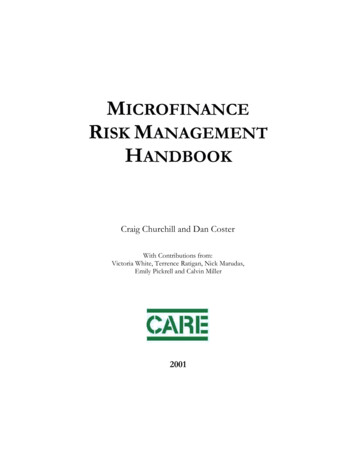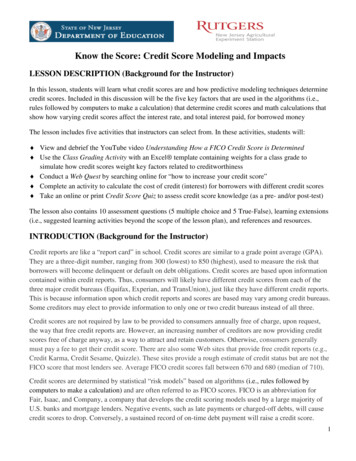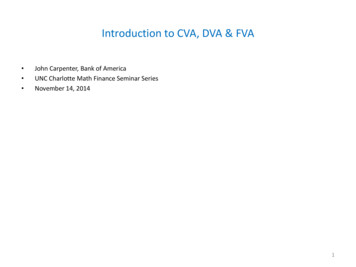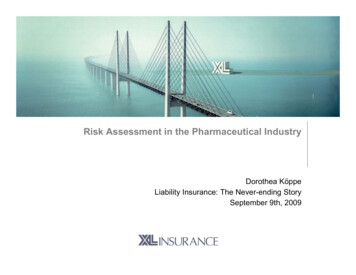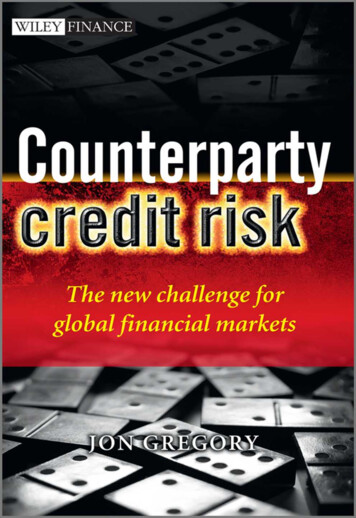
Transcription
This page intentionally left blank
Counterparty Credit Risk
For other titles in the Wiley Finance seriesplease see www.wiley.com/finance
Counterparty Credit RiskThe New Challenge for Global Financial MarketsJon GregoryA John Wiley and Sons, Ltd, Publication
This edition first published in 2010Copyright # 2010 John Wiley & Sons LtdRegistered officeJohn Wiley & Sons Ltd, The Atrium, Southern Gate, Chichester, West Sussex, PO19 8SQ, United KingdomFor details of our global editorial offices, for customer services and for information about how to apply forpermission to reuse the copyright material in this book please see our website at www.wiley.comThe right of the author to be identified as the author of this work has been asserted in accordance with theCopyright, Designs and Patents Act 1988.All rights reserved. No part of this publication may be reproduced, stored in a retrieval system, or transmitted,in any form or by any means, electronic, mechanical, photocopying, recording or otherwise, except aspermitted by the UK Copyright, Designs and Patents Act 1988, without the prior permission of the publisher.Wiley also publishes its books in a variety of electronic formats. Some content that appears in print may not beavailable in electronic books.Designations used by companies to distinguish their products are often claimed as trademarks. All brandnames and product names used in this book are trade names, service marks, trademarks or registered trademarks of their respective owners. The publisher is not associated with any product or vendor mentioned in thisbook. This publication is designed to provide accurate and authoritative information in regard to the subjectmatter covered. It is sold on the understanding that the publisher is not engaged in rendering professionalservices. If professional advice or other expert assistance is required, the services of a competent professionalshould be sought.ISBN 978-0-470-68576-1A catalogue record for this book is available from the British Library.Project Management by OPS Ltd, Gt Yarmouth, NorfolkTypeset in 10/12pt TimesPrinted in Great Britain by CPI Antony Rowe Ltd, Chippenham, Wiltshire
ContentsAcknowledgementsxviiList of SpreadsheetsxviiiList of 999101011Setting the Scene1.1Financial risk management1.1.1Market risk1.1.2Liquidity risk1.1.3Operational risk1.1.4Credit risk1.1.5Value-at-risk1.1.6Disadvantages of value-at-risk1.2The failure of models1.2.1Why models?1.2.2Good model, bad model1.3The derivatives market1.3.1What is a derivative?1.3.2Market structure1.4Risks of derivatives1.4.1Too big to fail1.4.2Systemic risk1.4.3Compensation culture1.4.4Credit derivatives1.5Counterparty risk in context1.5.1What is counterparty risk?1.5.2Mitigation of counterparty risk1.5.3Counterparty risk and integration of risk types1.5.4Counterparty risk and today’s derivatives market
vi2ContentsDefining Counterparty Credit Risk2.1Introducing counterparty risk2.1.1Origins of counterparty risk2.1.2Repos2.1.3Exchange-traded derivatives2.1.4OTC derivatives2.1.5Counterparty risk2.1.6Counterparty risk versus lending risk2.1.7Mitigating counterparty risk2.1.8Counterparty risk players2.2Components and terminology2.2.1Credit exposure2.2.2Default probability and credit acement cost2.2.6Exposure2.2.7Exposure as a short option position2.2.8Potential future exposure (PFE)2.3Controlling counterparty credit risk2.3.1Trading with high-quality counterparties2.3.2Cross-product lkaway features2.3.6Monolines2.3.7Diversification of counterparty risk2.3.8Exchanges and centralised clearing houses2.4Quantifying counterparty risk2.4.1Credit lines2.4.2Pricing counterparty risk2.4.3Hedging counterparty risk2.4.4Capital requirements and counterparty risk2.5Metrics for credit exposure2.5.1Expected MtM2.5.2Expected exposure2.5.3Potential future exposure2.5.4EE and PFE for a normal distribution2.5.5Overview of exposure metrics2.5.6Expected positive exposure2.5.7Effective EPE2.5.8Maximum PFE2.6SummaryAppendix 2.ACharacterising exposure for a normal 25252627272829292930303233343535353636363738383839
Contents3Mitigating Counterparty Credit Risk3.1Introduction3.1.1Two-way or one-way agreements3.1.2Standardisation3.2Default-remote entities3.2.1High-quality counterparties3.2.2Special purpose vehicles3.2.3Central counterparties3.3Termination and walkaway features3.3.1Termination events3.3.2Additional termination events3.3.3Walkaway features3.4Netting and close-out3.4.1Close-out3.4.2Payment and close-out netting3.4.3The need for close-out netting3.4.4The birth of netting3.4.5Netting agreements3.4.6The ISDA Master Agreement3.4.7Product coverage3.4.8Netting and exposure3.4.9Advantages and disadvantages of netting3.4.10 Multilateral netting3.5Netting and exposure3.5.1Negativity of MtM3.5.2Impact of correlation3.5.3Negative MtM of a netting set3.5.4Positive MtM of a netting set3.6Collateral3.6.1The basics of collateralisation3.6.2Analogy with mortgages3.6.3Setting up a collateral agreement3.6.4Valuation agent3.6.5Types of collateral3.6.6Coverage of collateralisation3.6.7Disputes and reconciliations3.7The mechanics of collateralisation3.7.1Linkage of collateral parameters to credit quality3.7.2Margin call frequency3.7.3Threshold3.7.4Independent amount3.7.5Minimum transfer 26363646565666667686868
viii4Contents3.7.8Coupons and interest payments3.7.9Substitution, reuse of collateral and rehypothecation3.7.10 Call-and-return example3.8Is risk mitigation always a good thing?3.9SummaryAppendix 3.AEE of independent normal variables707171737474Quantifying Counterparty Credit Exposure, I4.1Quantifying credit exposure4.1.1Mark-to-market þ add-ons4.1.2Semi-analytical methods4.1.3Monte Carlo simulation4.1.4Roll-off risk4.2Typical credit exposures4.2.1Loans, bonds and repos4.2.2Swaps4.2.3FX products4.2.4Options4.2.5Credit derivatives4.2.6Payment frequencies4.2.7Exercise dates4.3Models for credit exposure4.3.1Calibration4.3.2Risk-neutral or it spreads4.3.7Interest rates4.3.8Advanced models4.3.9Model validation4.3.10 Correlations4.4Netting4.4.1Modelling netting4.4.2Netting factor4.4.3Examples4.5Exposure contributions4.5.1Marginal EE4.5.2Simple two-trade marginal EE example4.5.3Marginal EE and correlation4.5.4General example4.6SummaryAppendix 4.ASemi-analytical formula for exposure of a forwardcontractAppendix 4.BComputing marginal 9798989999101102102103104104105106
Contents56ixQuantifying Counterparty Credit Exposure, II: The Impact of Collateral5.1Introduction5.2The impact of collateral on credit exposure5.2.1Remargin period5.2.2Potential future exposure with collateral5.2.3Volatility of exposure5.2.4Collateral volatility5.2.5Correlation between collateral and exposure5.3Modelling collateral5.3.1Parameters5.3.2Collateral logic5.4Full 3Exposure distributions5.4.4Simple approximation – idealised case5.4.5Simple approximation – impact of minimum transferamount5.4.6Impact of threshold5.4.7Simple approximation – impact of threshold5.4.8Operational cost versus reduction of exposure5.5The risks of collateralisation5.5.1Operational risk5.5.2Default risk5.5.3FX risk5.5.4Liquidity and liquidation risk5.6SummaryAppendix 5.ACalculation of collateralised PFE (cash collateral)Appendix 5.BCalculation of collateralised netted exposure withcollateral value uncertaintyAppendix 5.CMathematical treatment of a collateralised 116117126126Overview of Credit Risk and Credit Derivatives6.1Defaults, recovery rates, credit spreads and credit derivatives6.1.1Default rates6.1.2Recovery rates6.1.3Credit spreads6.2Credit derivatives6.2.1Market growth and uses6.2.2Credit default swaps (CDSs)6.2.3Credit-linked notes6.2.4Asset swaps6.2.5Linkage between bonds, asset swaps and CDS premiums6.2.6Contingent credit default swap (CCDS)6.2.7Fixed and digital CDSs and recovery 121122123123124124124125125
.3.7default swapsReference entity and obligationCredit eventsSettlement of CDSCheapest-to-deliver option and restructuringDelivery squeezeCDS risksISDA 2009, Big Bang Protocol, Small Bang Protocol andnew trading conventions6.4Estimating default probability6.4.1Defining default probability6.4.2Historical estimation6.4.3Equity-based approaches6.4.4Market-implied default probabilities6.5Portfolio credit derivatives6.5.1CDS index products6.5.2Index tranches6.5.3Super senior risk6.5.4Collateralised debt obligations6.5.5CDO investors6.5.6Rating of CDOs6.5.7SummaryAppendix 6.ADefining survival and default probabilitiesAppendix 6.BPricing formulas for CDSs and risky bondsAppendix 6.CPricing of index 155156159160161162162163163166Pricing Counterparty Credit Risk, I7.1Pricing counterparty risk7.1.1Motivation7.1.2Why pricing counterparty risk is not easy7.1.3Credit value adjustment (unilateral)7.1.4Practical CVA formula (no wrong-way risk)7.1.5CVA as a spread7.1.6CVA semi-analytical methods7.1.7How to calculate the EE for CVA7.2Pricing new trades using CVA7.2.1CVA formula with collateral7.2.2CVA formula with netting7.2.3Netting and trade size7.2.4Marginal CVA7.2.5Exotic products7.2.6Path dependency7.3Bilateral counterparty risk7.3.1Background7.3.2Bilateral 6178178180181181181182183
Contents8xi7.3.4BCVA formula from credit spread7.3.5BCVA or CVA?7.3.6BCVA and break clauses7.3.7BCVA and unwinding trades7.3.8Walkaway features7.4SummaryAppendix 7.ADeriving the equation for credit value adjustment (CVA)Appendix 7.BApproximation to the CVA formula in the case of nowrong-way riskAppendix 7.CApproximation linking CVA formula to credit spreadAppendix 7.DSpecific approximations to the CVA formula forindividual instrumentsAppendix 7.ECalculation of CVA increase in the presence of nettingAppendix 7.FDeriving the equation for bilateral credit valueadjustment (BCVA)Appendix 7.GApproximation linking CVA formula to credit spreadsfor bilateral CVAAppendix 7.HDeriving the equation for BCVA under the assumptionof a bilateral walkaway clause185186188189190191192Pricing Counterparty Credit Risk, II: Wrong-way Risk8.1Introduction8.2Wrong-way risk8.2.1Empirical evidence of wrong-way risk effects8.2.2Right-way risk8.2.3Examples of wrong-way risk trades8.2.4Wrong-way risk and CVA8.3Measuring wrong-way risk8.3.1Correlation is not the same as dependence8.3.2Simple example8.3.3Forward trade example8.3.4Foreign exchange example8.3.5Comparison of wrong-way risk approaches8.3.6Risky option position8.3.7Wrong-way risk and bilateral counterparty risk8.3.8Wrong-way risk and collateral8.4Counterparty risk in CDSs8.4.1CDS payoff under counterparty default8.4.2Quantifying CVA for a CDS8.4.3Buying CDS protection8.4.4Selling CDS protection8.4.5Bilateral CDS counterparty risk8.5Counterparty risk in structured credit8.5.1Overview8.5.2Credit indices8.5.3Index 7199200
xiiContents8.5.4Super senior tranches8.5.5Counterparty risk distribution across capital structure8.5.6Impact of upfront tranche payments8.6Counterparty risk and gap risk8.6.1Motivation8.6.2TRS transactions8.6.3Leveraged CLN8.6.4Converting counterparty risk to gap risk8.7Super senior risk8.7.1The leveraged super senior (LSS) trade8.7.2Monolines8.7.3Credit derivatives products companies (CDPCs)8.7.4The value of protection purchased from monolines andCDPCs8.8SummaryAppendix 8.AComputing the EE of a typical forward exposure withcorrelation to a time of defaultAppendix 8.BFormula for a risky optionAppendix 8.CFormula for pricing a CDS contract with counterpartyriskAppendix 8.DPricing of a leveraged super senior tranche9Hedging Counterparty Risk9.1Introduction9.2Hedging and pricing9.3Hedging a risky derivative position9.4Traditional hedging of bonds, loans and repos9.5Risk-neutral or real parameters?9.5.1Futures prices and future spot Components of CVA9.7Recovery risk9.7.1Basis risk9.7.2CVA sensitivity to recovery9.7.3Recovery swaps9.8Static hedging9.8.1Static CDS hedging of exposures9.8.2Contingent credit default swaps (CCDSs)9.9Dynamic credit hedging9.9.1Credit delta9.9.2Gamma9.9.3Jump-to-default risk9.9.4Credit hedging with 256256257257258260260261262264
Contents10xiii9.10Exposure9.10.1 Hedging spot rates9.10.2 Spot rates and drift9.10.3 Volatility9.10.4 Spot rate sensitivity under volatility hedging9.11 Cross-dependency9.11.1 Cross-gamma and wrong-way risk9.11.2 Hedging wrong-way risk9.11.3 Monolines9.11.4 Hedging bilateral counterparty risk9.11.5 Impact of collateralisation on hedging9.12 Aggregation of sensitivities9.13 SummaryAppendix 9.AExample of calculation of CVA rtfolio Models and Economic Capital10.1 Introduction10.2 Joint default10.2.1 Double-default approach10.2.2 Merton-style approach10.2.3 Impact of correlation10.2.4 Impact on CCDS10.2.5 Distribution of losses10.2.6 Impact of random exposure10.2.7 Impact of correlated exposures10.3 Credit portfolio losses10.3.1 Loss distributions and unexpected loss10.3.2 Impact of correlation10.3.3 Default-only approaches10.4 The impact of stochastic exposure10.4.1 Impact of random exposure on unexpected loss10.4.2 The alpha factor10.4.3 Example of alpha correction10.4.4 Sensitivity analysis on the alpha factor10.5 Special cases of alpha10.5.1 Correlation of exposures10.5.2 Asymmetric exposure10.5.3 Wrong-way risk10.5.4 What is the correct value of alpha?10.6 Credit migration and mark-to-market10.6.1 The importance of mark-to-market10.6.2 Modelling credit migrations10.6.3 Marking-to-market loans10.6.4 Marking-to-market derivatives10.6.5 91292293295296296297297298300301301301302303303
xiv1112Contents10.7 SummaryAppendix 10.A Credit portfolio modelAppendix 10.B Simple treatment of wrong-way risk304305307Counterparty Risk, Regulation and Basel II11.1 Introduction11.2 The birth of Basel II11.3 Basel II Framework for fixed exposures11.3.1 Overview11.3.2 The advanced IRB approach11.3.3 Asset correlation11.3.4 Maturity factor11.4 Exposure at default and Basel II11.4.1 Current exposure method11.4.2 Standardised method11.4.3 Treatment of repo-style transactions11.5 Basel II internal model method11.5.1 Introduction11.5.2 Effective maturity11.5.3 Exposure at default11.5.4 Defining alpha11.5.5 Effective EPE for collateralised counterparties11.6 Basel II and double-default11.6.1 Background11.6.2 Double-default formula11.6.3 Double-default adjustment factor11.6.4 Accounting for double-default for derivatives11.7 SummaryAppendix 11.A Effective remaining maturityAppendix 11.B The asset correlation and maturity adjustment formulasin the advanced IRB approach of Basel IIAppendix 11.C Netting and collateral treatment under the currentexposure method (CEM) of Basel IIAppendix 11.D Definition of effective EPEAppendix 11.E Double-default treatment of hedged exposures inBasel 321322323323324324326327328Managing Counterparty Risk in a Financial Institution12.1 Introduction12.2 Counterparty risk in financial institutions12.2.1 Components12.2.2 Counterparty risk group12.2.3 Responsibilities12.2.4 Organisational structure12.2.5 Mechanics of pricing12.2.6 Default settlement12.2.7 Technology aspects333333333333335335336336337337329329330331
Contents12.312.412.512.6Insurance company or trading desk?12.3.1 Background12.3.2 Insurance approach12.3.3 Trading desk approach12.3.4 Profit centre or not?12.3.5 Finding the balanceHow to calculate credit charges12.4.1 Real or risk-neutral?12.4.2 Default probabilities12.4.3 Drift, volatility and correlations12.4.4 Mark-to-market12.4.5 Bilateral credit chargesHow to charge for counterparty risk12.5.1 Lookup tables12.5.2 Stand-alone pricing12.5.3 Pricing incorporating risk mitigants12.5.4 Allocation of 534634634634734913Counterparty Risk of Default-remote Entities13.1 The triple-A counterparty13.1.1 The need for institutions with long-term views13.1.2 Derivatives product companies13.1.3 Monolines13.1.4 Credit derivatives products companies13.2 The value of monolines and CDPCs13.2.1 Moral hazard13.2.2 Rating agencies and triple-A entities13.2.3 Credit insurer simple example13.2.4 Suspension modes, downgrades and death spirals13.2.5 Termination mode and run-off13.2.6 The random leverage effect13.2.7 The future for credit insurers13.3 SummaryAppendix 13.A Simple model for a credit insurerAppendix 13.B The valuation of credit insurer purchased 6436536536514The Role of a Central Counterparty14.1 Centralised clearing14.1.1 Background14.1.2 Systemic risk in the derivatives markets14.1.3 Historical background to CCPs14.1.4 Bilateral netting versus centralised clearing14.1.5 Novation14.1.6 The operation of a CCP14.1.7 Impact of default of a CCP member369369369370371372373374374
xviContents14.214.31514.1.8 Initial margin14.1.9 Reserve funds and loss mutualisationThe viability of centralised clearing14.2.1 The advantage of centralised clearing14.2.2 The disadvantages of centralised clearing14.2.3 Risk homogeneity and asymmetric information14.2.4 Competition14.2.5 Market coverage of a CCP14.2.6 Central counterparties and credit derivatives14.2.7 Under what circumstances will a CCP work?ConclusionsThe Future of Counterparty Risk15.1 A counterparty risk revolution?15.2 Controlling credit exposure15.3 Collateral management15.4 The too-big-to-fail concept15.5 Credit value adjustment (CVA)15.6 Hedging15.7 Credit derivatives15.8 Central counterparties15.9 The overall x411
AcknowledgementsI would first like to acknowledge Michael Pykhtin and Dan Rosen who initially hadthe idea for this book, which they discussed with me in Geneva in December 2008. Iwould like to further thank Michael Pykhtin for reading and providing invaluablecomments on initial chapters and for collaborating on the writing of Chapter 11. I havebeen lucky to be able to call on informal referees for draft chapters, namely KirkBuckley, Darrell Duffie, Alex Gu, Andrew Green, Jean-Paul Laurent, Matthew Leeming, John Ovens, Vladimir Piterbarg, David Rowe, Lutz Schloegl and Tom Wilde. I amvery grateful to these people for reading early drafts of chapters and putting up with thespelling mistakes and bad grammar to provide some invaluable suggestions. Needless tosay, I take responsibility for any remaining errors.I would like to thank Pete Baker, Aimee Dibbens and Viv Wickham at John Wiley &Sons for their excellent support during this project and to Neil Shuttlewood at OPS forworking so quickly and efficiently at the copy-editing stage.Thanks finally to my daughter Christy, son George and wife Ginnie for putting upwith me during the writing process.Jon GregoryDecember 2009
SpreadsheetsThe following spreadsheets have been prepared to allow the reader to gain some simpleinsight into some of the quantitative aspects discussed in the main text. The spreadsheetscan be downloaded freely from my website www.oftraining.com under the counterpartyrisk section. Many of these examples have been used for training courses and havetherefore evolved to be quite intuitive and user-friendly. New examples will be addedover time. Any questions then please email me at tSpreadsheetSpreadsheet2.12.22.33.13.2Spreadsheet 4.1Spreadsheet 4.2Spreadsheet sheet 10.2Spreadsheet 13.1Counterparty risk for an FX forward tradeEE and PFE for a normal distributionEPE and effective EPE exampleSimple netting calculationCall-and-return collateral example with logic relating to independentamounts, thresholds, collateral held, minimum transfer amount androundingExposure calculation for a forward contractSimulation of an interest rate swap exposure with a one-factorHull–White modelIllustration of the impact of netting for interest rate andcross-currency swapsMarginal exposure calculationQuantifying the impact of collateral on exposureAnalysis of historical default probabilitiesImplementation of Merton modelCalculating market-implied default probabilitiesSimple CVA calculationSemi-analytical calculation of the CVA for a swapWrong-way risk calculations of expected exposureBlack–Scholes formula with counterparty riskCalculation of joint default probabilities with a bivariate normaldistribution functionCalculation of unexpected losses and ‘‘alpha’’ factor for a creditportfolio with random exposuresSimple credit insurer 284290358
CDDDPCEADEDFEEAsset-Backed SecurityAmerican International Group Inc.AIG Financial ProductAsset SWapAdditional Termination EventBasel Committee on Banking SupervisionBilateral Credit Value AdjustmentBlack–Scholes–MertonCapital Asset Pricing ModelContingent Credit Default SwapCredit Conversion FactorCentral CounterPartyCollateralised Debt ObligationCredit Derivative Product CompanyCredit Default SwapCurrent Exposure MethodCashFlowCommodity Futures Trading CommissionCredit-Linked NoteConstant Proportion Portfolio InsuranceCentral Processing UnitCounterparty Risk GroupCredit Support AmountCollateralised Synthetic ObligationCredit Value AdjustmentDrexel–Burnham–LambertDetermination CommitteeDistance to DefaultDerivatives Product Company (or Corporation)Exposure At DefaultExpected Default FrequencyExpected Exposure
onsEffective Expected Positive ExposureExpected Positive ExposureEnterprise Risk ManagementEarly Termination OptionExtreme Value TheoryForeign eXchangeGroup of TenGeneral Clearing MemberIndividual Clearing MemberInternal Model Method; International Monetary MarketInternal Ratings BasedInterest Rate SwapInternational Swaps and Derivatives AssociationLoss Given DefaultLarge Homogeneous PoolLondon Inter-Bank Offer RateLeveraged Super SeniorLong Term Capital ManagementMaturity AdjustmentMortgage-Backed SecurityModified Modified RestructuringModified RestructuringMinimum Transfer AmountMark-to-MarketNorth AmericanNet Asset ValueNon-Clearing MemberRatio of current Net exposure to current GRoss exposureNo NettingNetting SetOver The CounterProbability of DefaultPotential Future ExposurePriceWaterhouseCooperRegulatory CapitalReference Entity DatabaseStandard & PoorStandards of Financial Accounting StatementStructured Finance TransactionStructured Investment VehicleStandardised MethodStandard Portfolio Analysis of RiskSpecial Purpose EntitySpecial Purpose VehicleTotal Return SwapValue-at-RiskWithdrawn Rating
IntroductionTHE NEW CHALLENGE FOR GLOBAL FINANCIAL MARKETSIn 2007 we started to experience what would be the worst financial crisis since the 1930s.The crisis spread from origins in the United States to become a global crisis. It alsospread rapidly from the financial markets to have a significant impact on the realeconomy. Some financial institutions failed including the extremely high profile bankruptcy of the investment bank Lehman Brothers founded in 1850. Even more financialinstitutions would have failed were it not for government bailouts.The first decade of the 21st century has been disastrous for derivatives and financialrisk management. One area that needs special attention is that of counterparty creditrisk, often known simply as counterparty risk. Counterparty risk arises from the creditrisk in securities financing transactions such as repos and the vast and often complexOTC (over-the-counter) derivatives market. For example, Lehman Brothers had anotional amount of 800 billion of OTC derivatives at the point of bankruptcy. Inaddition, the complex web of transactions, collateral positions and structures such asSPVs (special purpose vehicles) needing to be unwound during the Lehman’s bankruptcy has provided a reminder of the presence and complexity of counterparty riskswithin the financial system.The use of derivatives among companies is widespread although the majority of therisk is centralised among financial institutions and further concentrated amongst thelargest banks or ‘‘dealers’’. Non-financial users of derivatives tend to apply them onlyfor hedging specific risks. Banking institutions did not fail because of unprofitable OTCderivatives-trading activities. However, derivatives do have the potential to create acomplex web of transactions and also allow much of the leverage that can bringabout major market disturbances. Furthermore, the complexity and bilateral natureof derivatives, together with the rapidly moving financial markets, means that thefinancial instability of a large institution can easily cause major shockwaves throughthe entire highly connected financial system.Whilst Lehman Brothers was the only high-profile default of the credit crisis, manyother large financial institutions (for example, Bear Stearns, AIG, Fannie Mae, FreddieMac, Merrill Lynch, Royal Bank of Scotland) needed external support (mainly government) to avoid their failure. The ‘‘too big to fail’’ mentality that seemingly existed in the
xxiiIntroductionmarket has been thoroughly discredited and the failure or financial instability of anyinstitution large or small should be regarded as plausible. A key concern around thedefault of a large financial institution is the systemic risk arising from a cascade of eventsthat could lead to a major crisis within the financial markets. Such systemic risk episodesare of great concern and therefore need to be strongly mitigated against.A lack of proper assessment of credit exposure and default probability was a keydriver of the credit crisis from 2007 onwards. The too-big-to-fail illusion meant thatmany counterparties were given (perhaps only implicitly) zero or close to zero defaultprobability. Rating agencies were able to earn income from assessing securities that werepotentially far riskier than indicated by their given rating which in many cases turnedout to be inaccurate and of little value. Many years of laziness in assessing credit risk ledto a major crisis. Lessons need to be learned, a key one being that all institutions mustimprove their understanding, quantification and management of their counterpartyrisks.OVERVIEW OF THIS BOOKThis book is a comprehensive guide to the subject of counterparty risk for practitionersdealing with this or related topics. All aspects of counterparty risk and related areas arediscussed. Whilst financial risk management has tended to be rather quantitative inrecent years, there is a well-known danger in overuse of models and quantitativemethods. We aim to strike a balance by including quantitative material in appendicesfor the book, which are not compulsory. The main text can be read freely by the nonquantitative reader whilst appendices may be consulted by those wishing to go into moredetail on the underlying mathematical points. There are also spreadsheet examplesaccompanying the book that can be freely downloaded (see p. xviii).We begin the book with two introductory chapters: Chapter 1 sets the scene anddescribes counterparty risk in context with other financial risks (market, liquidity,operational, credit) and concepts such as VAR (value-at-risk). Chapter 2 introducesand defines counterparty risk, explaining the product coverage, components and important terminology and discusses many of the key topics that will be covered in more detailin later chapters.Netting and collateral reduces counterparty risk substantially with the overall exposure of firms reduced to a small fraction of their gross exposure. In Chapter 3 we discussthese risk mitigation techniques together with others such as termination events and theuse of default-remote entities that have been much utilised to limit counterparty risk. Wealso describe the importance of mitigation techniques in allowing the OTC derivativesmarket to grow exponentially in size and we consider the potential dangers of thebenefits of risk mitigation being overestimated.Derivatives can fluctuate from an asset to a liability position, hence both parties facecredit exposure over time. An important consideration for many financial institutionsfor many years has been the modelling of credit exposure and its use, together with creditlines, to control counterparty risk. Chapter 4 is dedicated to discussing the quantificationof credit exposure and describing methodologies, models and systems requirements.Chapter 5 follows on with a discussion on quantifying credit exposure in the presence ofcollateral agreements. With collateralisation becoming increasingly important and com-
Introductionxxiiimon, there is particular relevance to understand fully the extent to which collateralagreements change future credit exposure.Between 2001 and 2007, the notional value of outstanding credit default swaps(CDSs) grew by a factor of 100. Due to the turbulence in the credit markets, thecounterparty risk problem
1.1 Financial risk management 1 1.1.1 Market risk 1 1.1.2 Liquidity risk 2 1.1.3 Operational risk 2 1.1.4 Credit risk 2 1.1.5 Value-at-risk 3 1.1.6 Disadvantages of value-at-risk 3 1.2 The failure of models 4 1.2.1 Why models? 4 1

